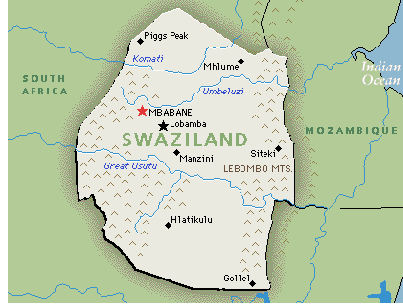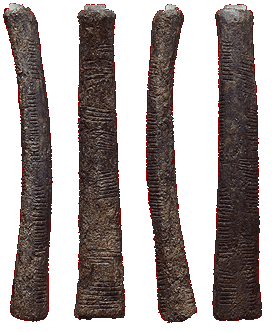Post all comments and Information about Central and Southern Africa in this Section.
Saturday, 5 July 2003 - 10:07 PM EDT
Name: Ibn Al Balad Misri
4,000 Years Ago in West Africa The Sahara desert continues to grow, pushing the borderland of the savanna (called the Sahel) further south. The pressure on the herdsmen of the Sahel to move south as pasture lands disappear also continues to increase. Overuse of pasture land, stripping away all plant cover allowing the soil to dry out completely, may have added to the problem of a climate that was already becoming drier. This process of desertification continues to this day. Numerous megaliths or standing stones exist in the area around Bouar in what is now the Central African Republic, sometimes called the African Stonehenge. Possibly built as tombs, similar to the stone tombs found in Europe, little is known about these ancient monuments. Usually the stones are set up in groups and were placed near river sources or at the entrances of valleys. The huge stones are typically 1.5 to 2 metres high, but some are up to 5 metres tall and weigh 4 tons. In the native language, these monuments are called tajunu.
back
www.edunetconnect.com - schoolmaster@baxter.net
http://www.edunetconnect.com/cat/timemachine/4000wa.html
Sunday, 6 July 2003 - 4:05 AM EDT
Name: Africulture
Journal of World Prehistory
16 (3): 197-235, September 2002
Copyright ? 2002 Plenum Publishing Corporation
All rights reserved
Human Responses to Changing Environments in Central Africa Between 40,000 and 12,000 B.P.
Els Cornelissen
Section of Prehistory and Archaeology, Royal Museum for Central Africa, Leuvense stw. 13, 3080 Tervuren, Belgium; ecornelissen@africamuseum.be
Abstract
Reconstructions of the Equatorial forest in Central Africa fuel the debate on whether hunter-gatherers at the end of the Pleistocene were capable of living in or off the forest prior to the advent of agriculture. Their traces are rare and often reduced to their stone equipment. In an attempt to see to what extent technology and environmental exploitation are interrelated, all Central African sites dated between 40,000 and 12,000 B.P. are analyzed for their material culture, the environmental setting at the time of the occupation, and the exploitation of that environment. Although the evidence is still circumstantial, two large technological traditions have been recognized in Central Africa at the end of the Pleistocene, the Lupemban and microlithic industries, and both are associated with a variety of environments. This, in combination with a fragmented forest and concomitant increase of ecotone during the Last Glacial Maximum, would have enhanced rather than hampered human occupation in the area. It may be argued that the inherent flexibility and capability of exploiting a variety of environments enabled the hunter-gatherer communities to face and adapt to environmental changes regardless of stone technology.
Monday, 7 July 2003 - 1:49 AM EDT
Name: Ibn_al_baladi_misri
Do you know anything about the Ishango culture? The Ishango bone is supposed to be around 8,000 years old and is contemporary with Kmt[Ta-Meri].
Wednesday, 9 July 2003 - 1:18 PM EDT
Name: Africulture
The oldest fossils of modern man are nearly 150,000 years old. Probably on a rainy day, a human walked in wet sand near what is now known as Border Cave in the Lebombo Mountains between South Africa and Swaziland. In the 1970's during the excavations of Border Cave, a small piece of the fibula of a baboon, the Lebombo bone, was found marked with 29 clearly defined notches, and, at 37,000 years old, it ranks with the oldest mathematical objects known. The bone is dated approximately 35,000 BC and resembles the calendar sticks still in use by Bushmen clans in Nimibia.

Wednesday, 9 July 2003 - 1:26 PM EDT
Name: Africulture
Most histories of mathematics devote only a few pages to Ancient Egypt and to northern Africa during the 'Middle Ages'. Generally they ignore the history of mathematics in Africa south of the Sahara and give the impression that this history either did not exist or, at least, is not knowable, traceable, or, stronger still, that there was no mathematics at all south of the Sahara. In history, to Europeans, even the Africanity of Egyptian mathematics is often denied or suffers eurocentric views of conceptions of both 'history' and of 'mathematics' form the basis of such views.
High in the mountains of Central Equatorial Africa, on the borders of Uganda and Zaire lies Lake Edward, a source of the Nile. It is a small lake (about 30 miles by 60 miles).
click map to download an expanded view
Though the area is sparsely populated today, approximately 9,000 (some say 20,000) to 6,000 years ago by the shores of the lake lived a small community that fished, gathered, and grew crops The settlement only existed a few hundred years before being buried in a volcanic eruption. The place where their remains were found has a name now given to these people - Ishango. Among their remains is the second oldest mathematical object (the oldest is here) in Africa


The most interesting, of a large number of tools discovered in 1960 at Ishango, is a bone tool handle called the Ishango Bone (now located on the 19th floor of the Royal Institute for Natural Sciences of Belgium in Brussels, and can only be seen on special demand). At one end of the Ishango Bone is a piece of quartz for writing, and the bone has a series of notches carved in groups (shown below). It was first thought these notches were some kind of tally marks as found to record counts all over the world. However, the Ishango bone appears to be much more than a simple tally. The markings on rows (a) and (b) each add to 60. Row (b) contains the prime numbers between 10 and 20. Row (a) is quite consistent with a numeration system based on 10, since the notches are grouped as 20 + 1, 20 - 1, 10 + 1, and 10 - 1. Finally, row (c) seems to illustrate for the method of duplication (multiplication by 2) used more recently in Egyptian multiplication. Recent studies with microscopes illustrate more markings and it is now understood the bone is also a lunar phase counter. Who but a woman keeping track of her cycles would need a lunar calendar? Were women our first mathematicians?